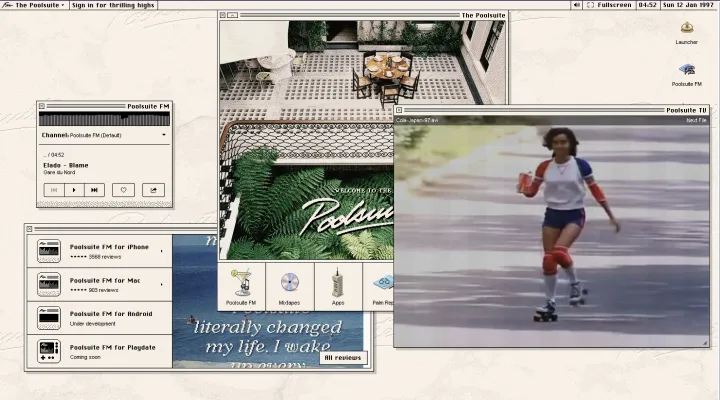The Revolution in Our Living Rooms: The Evolution of Home Computers
From hobbyist kits in 1975 to today's powerhouses, home computers transformed from curiosities to essential tools. The journey from the Altair 8800's blinking lights to modern machines mirrors our own evolution from tech observers to digital natives.
Remember when computers filled entire rooms? I do, but only from old photos. What fascinates me is how we went from those behemoths to the powerful machines that now sit in our homes, often collecting dust under piles of homework or serving as expensive cat beds. Let's explore this incredible journey together.
The Pioneers: When Home Computing Was a Dream (1975-1977)
It all started with a bunch of tech enthusiasts soldering components in their garages. The Altair 8800, launched in 1975, wasn't much more than a box of blinking lights, but it sparked something revolutionary. You had to toggle switches just to input programs, and the output? More blinking lights. Yet people went crazy for it, because for the first time, you could have your own computer.
Then came 1977, the year that changed everything. Three machines launched that would define home computing:
- The TRS-80: Radio Shack's bet on the future
- The Commodore PET: Looking like a dystopian TV from the future
- The Apple II: The sleek one that would transform education
The 8-bit Era: When Computers Got Personal (1980-1985)
The early 80s brought us what I like to call the "character-building computers" - machines that forced you to learn programming just to do anything useful. The Commodore 64 became the best-selling single computer model of all time, teaching an entire generation about BASIC programming through its iconic blue screen.
Meanwhile, across the pond, the BBC Micro was teaching British kids how to code, while the ZX Spectrum was showing everyone that computers could be affordable (if you didn't mind a rubber keyboard that felt like pressing dead insects).
The 16-bit Revolution: Getting Serious (1985-1991)
The Amiga 1000 dropped in 1985 like a bomb in the computing world. Suddenly, home computers could do real multimedia. The Amiga's ability to handle graphics and sound made it the go-to machine for creative professionals, while its gaming capabilities made it the dream machine for teenagers everywhere.
The Atari ST joined the party with its built-in MIDI ports, becoming the musician's choice. These machines weren't just toys anymore - they were serious tools that could handle professional work.
The IBM PC Clone Wars: Standards Emerge (1987-1995)
Here's where things get both boring and exciting at the same time. The IBM PC platform, with its open architecture, led to an explosion of clones. Companies like Compaq and Dell started making "IBM-compatible" machines that were often better than the original.
Windows 3.0 arrived in 1990, finally making PCs user-friendly(ish). The standardization around the PC platform meant software developers could focus on one architecture, leading to better programs for everyone.
The Multimedia Revolution: CD-ROMs Change Everything (1992-1998)
Remember the first time you installed a CD-ROM drive? That whirring sound as it spun up was the sound of the future. Suddenly, encyclopedias didn't need to take up an entire bookshelf, and games could have actual voice acting instead of beeps and boops.
The multimedia PC specifications helped standardize what a home computer should be capable of, leading to an explosion in educational software and games.
The Internet Changes the Game (1995-2000)
The sound of a modem connecting might be nostalgic now, but it was once the most exciting sound in computing - the gateway to a new world. Home computers evolved from stand-alone devices to communication tools. The internet transformed everything:
- Email became a daily necessity
- Instant messaging changed how we communicate
- Web browsers became the most important software
Modern Era: The Cloud and Beyond (2000-Present)
Today's home computers are simultaneously more powerful and less important than ever. With cloud computing, your actual hardware matters less than your internet connection. Smartphones have taken over many traditional computer tasks, yet we still rely on home computers for serious work.
The Impact on Society
The evolution of home computers fundamentally changed:
- How we work (remote work became possible)
- How we learn (online education)
- How we socialize (social media)
- How we create (digital art, music, writing)
- How we play (gaming, streaming)
Looking Forward
The future of home computing looks both exciting and uncertain. With virtual reality, artificial intelligence, and quantum computing on the horizon, we might be on the verge of another revolution in how we interact with these machines.
Cultural Legacy
The home computer revolution created:
- A generation of programmers who learned on their first home computers
- New forms of entertainment and art
- Changed expectations about technology's role in daily life
- A technological literacy that defines modern society
The story of home computers isn't just about technology - it's about how society transformed as these machines became part of our daily lives. From hobbyist kits to powerful workstations, each step in this evolution brought us closer to our current digital world.
What's most remarkable isn't just how far we've come, but how each generation of home computers solved problems we didn't even know we had, while creating new ones for the next generation to solve. It's a continuing journey that shows no signs of stopping.



